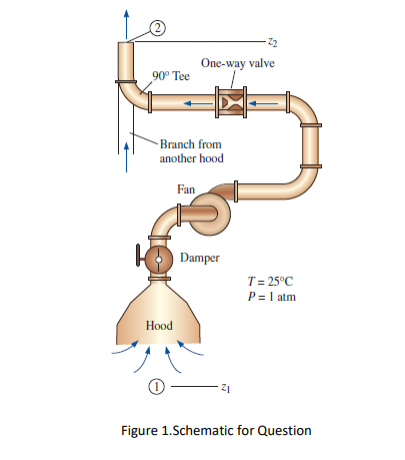A local ventilation system (a hood and duct system) is used to remove air and contaminants from a pharmaceutical lab (Fig. 1). The inner diameter (ID) of the duct is 129 mm, its average roughness is 0.15 mm, and its total length is L = 24.5 m. There are three elbows along the duct, each with a minor loss coefficient of 0.21. Literature from the hood manufacturer lists the hood entry loss coefficient as 3.3 based on duct velocity. When the damper is fully open, its loss coefficient is 1.8. The minor loss coefficient through the 90° tee is 0.36. Finally, a one-way valve is installed to prevent contaminants from a second hood from flowing “backward” into the room. The minor loss coefficient of the (open) one-way valve is 6.6. The performance data of the fan fit a parabolic curve of the form Havailable = H0 - aV2, where shutoff head H0 = 60.0 mm of water column, coefficient a = 2.50 x 10-7 mm of water column per (Lpm)2 ,available head Havailable is in units of mm of water column, and capacity ?̇ is in units of Lpm of air. Estimate the volume flow rate in Lpm through this ventilation system.
A local ventilation system (a hood and duct system) is used to remove air and contaminants from a pharmaceutical lab (Fig. 1). The inner diameter (ID) of the duct is 129 mm, its average roughness is 0.15 mm, and its total length is L = 24.5 m. There are three elbows along the duct, each with a minor loss coefficient of 0.21. Literature from the hood manufacturer lists the hood entry loss coefficient as 3.3 based on duct velocity. When the damper is fully open, its loss coefficient is 1.8. The minor loss coefficient through the 90° tee is 0.36. Finally, a one-way valve is installed to prevent contaminants from a second hood from flowing “backward” into the room. The minor loss coefficient of the (open) one-way valve is 6.6. The performance data of the fan fit a parabolic curve of the form Havailable = H0 - aV2, where shutoff head H0 = 60.0 mm of water column, coefficient a = 2.50 x 10-7 mm of water column per (Lpm)2 ,available head Havailable is in units of mm of water column, and capacity ?̇ is in units of Lpm of air. Estimate the volume flow rate in Lpm through this ventilation system.

Trending now
This is a popular solution!
Step by step
Solved in 8 steps with 9 images


